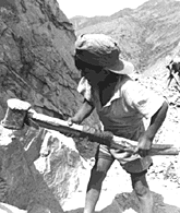|
Sustainable Design Awards Toolkit
Section 1.4 - Manufacture Abroad i) Cheaper labour Companies often chose to move their manufacturing departments abroad, partly because of the cheaper labour available, but other reasons include being closer to suppliers and being closer to new markets. This provides employment to the citizens of the host country, but jobs are lost in the country that the company has moved from. Britain alone has lost a large part of its manufacturing industry, with the majority being lost to countries that offer cheaper labour. One textile factory is closed every day in Britain6, and imports have risen by 40% in the last five years. The textile industry used to be Britain's largest employer, but now is the fourth largest manufacturing employer, employing more than 340,000. The motor industry has also been badly affected, with highly publicised closures across the country. CASE STUDY James Dyson, the inventor of the famous dual cyclone bagless vacuum cleaners, has also decided to move his manufacturing base to the Far East. He has been a long-standing supporter of British manufacture and this decision has shocked employees and trade unionists.ii) Environmental legislation As environmental laws demand increasingly high levels of performance, companies are moving manufacture to countries without such strict laws, or to countries who have not got the resources to enforce their environmental policies. CASE STUDY In the border regions between the USA and Mexico, there persists the illegal disposal of hazardous waste, posing significant threat to human health and the environment, and contaminating ground water supplies.
iii) Working conditions Moving manufacture to third world countries provides jobs and incomes to people who are grateful for the opportunity. However, employers know that there is a great need for employment in these countries, enabling some employers to take advantage of their employees. Human rights are compromised by the working conditions in many factories and manufacturing plants, and employees often have to work in appalling conditions, but because they rely on their income from the job, they are unlikely to complain or refuse to work in the conditions. The infrastructure is also weaker, without access to unions or fair representation. As investors, these companies have enormous potential to save money, but also to help improve the situation in their host country. If a little of their savings was put back into the workers' lives, e.g. through health care, education or pensions, the company would be investing in the future of their workers and this would help to break the cycle of dependence, and improve relations between the company, the community and the consumer. Unfortunately, the companies that operate in these conditions are unlikely to respond to workers' complaints or demands, but they will react quickly if their sales are threatened. Consumer groups have influenced companies such as Nike to improve the conditions in their factories. Consumers have a great influence over a company's behaviour, by wielding a strong weapon against exploitation - the weapon is buying power. iv) Child labour In families with low incomes, generally in developing countries, sending a child to school is not only expensive in terms of fees and books, but also in terms of loss of potential income. If that child can work instead of attending school, he or she can bring an extra income to the family. Additionally, if the child has no family to provide support, he or she is forced to work, in order to survive. Some employers, both foreign and native, see this need for employment as an opportunity to reduce manufacturing costs, and they employ the child on a low salary, often in poor working conditions. Young children are forced into the working environment, potentially hindering their natural growth - physical, educational and emotional.
According to Geeta Dharmarajan in her interview with One World Online in 1997, child labour is highest in areas of high adult unemployment. She states that "Parents could get employment if their children were not working - but children are cheaper."Paulo Evaristo Lins, the Cardinal of Sao Paulo, Brazil believes that "Unemployment destroys societies, but child labour shames all society".Consumer groups are putting pressure on the government to require labels stating whether child labour has or has not been used in the manufacture of each product. However, in communities where child labour has been banned, and factories have stopped employing children, there has been an outcry by the children themselves. The reason that the children work in bad conditions is that they need to work, and preventing child labour results in preventing needy children to take action against their poverty. Geeta Dharmarajan acknowledges poverty as the driving force behind children going to work, but believes thatImagine that you have no money to buy food, and you have to work for survival. A law is passed by people whose children eat three times a day, that prevents you from earning the money you need to eat at all. How do you feel? So how are the wrongs of child labour confronted, without denying the children's own needs and human rights? Some suggestions are shown below.Child labour is self-defeating: if a child cannot study, then the cycle of poverty is repeated - and she will never get out of the slum.
6.According to the Knitwear, Footwear and Apparel Trades Union 7.source: www.bbc.co.uk - last visited 23-06-2020 8.Please note that no reference is drawn between Dyson's manufacture abroad and indications elsewhere in this report of poor working conditions abroad 9.Image courtesy of www.oneworld.net/guides/ chld_labour/front.shtml - last visited 23-06-2020 10.Images are courtesy of http://www2.gol.com/users/bobkeim/child_labour/ and New Internatioalist, July 1997 edition
|
Sustainability Issues
|
|||||||||||||
| � | |||||||||||||
Toolkit Index
|






